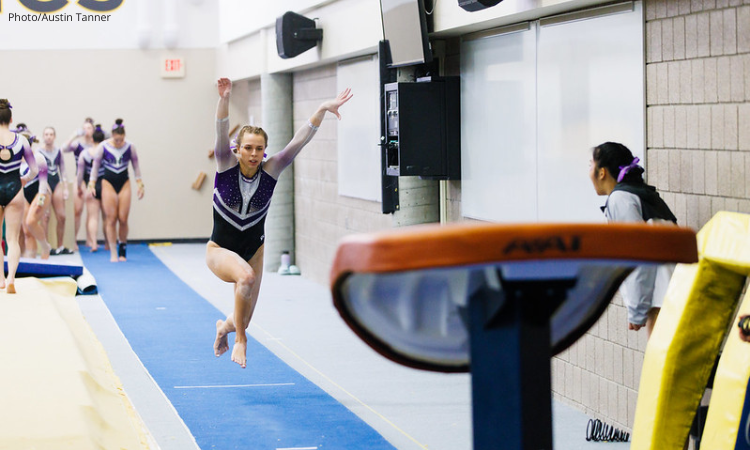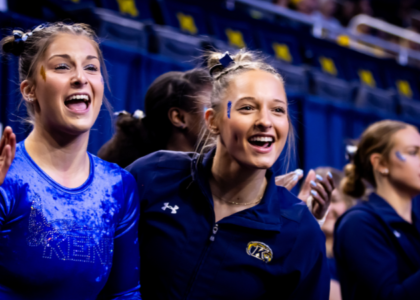Gymnastics can be a dangerous sport. So often when a gymnast works on gaining a new skill, the first step is learning it over a pit. A loose foam pit creates the perfect safety barrier to train new skills with minimal fear from both gymnasts and coaches alike. When looking for a gym, parents and gymnasts tend to prioritize gyms that have a foam pit. So it might come as a surprise that there are a few college gymnastics facilities that lack an in-house foam pit. Until this past summer, and despite being D1, Kent State was one of those schools.
When asked, Kent State senior, Kyndall Gilbert, raved about the loose foam pit behind the vault table which was added during the facility upgrade over the summer. She is excited for her Yurchenko one and a half on vault, adding “I don’t think I would have been able to get it as quickly if we didn’t have the pit.” Before the addition of their own foam pit, the team would have to drive to a nearby club gym. “It was inconvenient and it took a lot of time,” said graduate student Karlie Franz. “For freshmen, they’re comfortable in our pit space and they feel like they can learn new skills without holding back.”
Not only are foam pits useful for learning new skills, but they are also helpful in minimizing the load on athletes’ bodies. “It’s nice that we can do more numbers and get more turns in, because we have the soft landings and can stop beating up our bodies as much,” Gilbert said.
Looking at the development of both individual gymnasts and teams overall, it seemed relevant to take a more in-depth look at the impact, or lack thereof, of foam pits on college gymnastics teams. Using Division III NCGA gymnastics teams as the sample, our data team conducted research regarding the prevalence of pits throughout Division III college gymnastics, specifically as it relates to vault. Vault was chosen as the target event since start value is a big factor for team success on this event, and a pit is the easiest way to upgrade vaults. It’s also an event, along with floor exercise, that takes a serious toll on an athlete’s body, and allowing for no-impact landings can help stave off injuries.
The sample size for this analysis included only NCGA Division III teams that competed last year, allowing data to be collected and analyzed. Additionally, only permanent, loose foam pits behind a vault table were taken into account when deciding whether a gym would be defined as having a pit or not. Alternative, soft-landing options like inflatable pits or resi mats did not satisfy this criterion. Some of the following programs may have had a pit located somewhere else in the gym but did not have one behind their vault tables.
| Team | Conference | Do they have a pit in their facility? | Did they qualify for Nationals in 2023? |
| SUNY Brockport | East | Yes | Yes |
| University of Wisconsin-Oshkosh | West | No | Yes |
| University of Wisconsin- Lacrosse | West | No | Yes |
| University of Wisconsin-Whitewater | West | No | No |
| Ithaca College | East | Yes | Yes |
| University of Wisconsin- Stout | West | No | Yes |
| Springfield College | East | Yes | Yes |
| SUNY Cortland | East | Yes | No |
| Ursinus College | East | No | No |
| Rhode Island College | East | Yes | No |
| Gustavus Adolphus College | West | Yes | No |
| Winona State University | West | Yes | No |
| University of Wisconsin- Eau Claire | West | No | No |
| Hamline University | West | No | No |
Of the 14 programs in the NCGA, half of the practice facilities had pits while the other half did not. The lack of pits in Division III gymnastics is unique within the overall college gymnastics landscape. Among Division I gymnastics facilities, it is rare to see a facility without at least one foam pit, and many of the top programs have multiple vault tables with an array of landing surfaces. The facility at LSU, for example, has three vault runways: one into foam, one onto a resi, and a third onto a competition surface.
There are a total of 14 NCGA gymnastics teams, with six teams located in the East Coast Conference and eight in the West Coast Conference. We looked at the distribution of foam pits in the East versus the West and found that there is a higher concentration of foam pits in the East: 85% of teams in the East have foam pits as opposed to only 25% of teams in the West.
Next, we analyzed the effect having a training gym with a foam pit would have on a team’s likelihood of qualifying to nationals. To measure a program’s success, we looked at programs within the NCGA that made it to nationals last season and which of those teams had a pit. The numbers show that 50% of teams that qualified to the 2023 NCGA national championships had a foam pit and the other 50% did not, demonstrating that, at least within the structure of this analysis, there is no correlation between having a foam pit and qualifying to nationals. Furthermore, all qualifying teams from the East had a foam pit while those from the West did not.
Next, we looked specifically at vault. Twisting vaults are a prized possession in Division III gymnastics. In a world full of Yurchenko layouts, a lineup full of twisting or high start value vaults will set a team apart. Upgrading a layout vault to a twisting vault is a process that takes time, determination, and usually, a pit. A Yurchenko full, handspring front, or tsuk full is not a vault that can or should be landed onto a resi or hard landing without proper preparation. This would lead to the assumption that lacking a pit would impede upgrading a vault. Teams without a pit are given a few options: recruit girls that already have twisting vaults, have athletes learn them over the summer, find a local club gym that would allow the team to use the facilities, or let your athletes compete the skill without proper training and pray they don’t injure themselves.
To measure the theory that the lack of a pit would affect a team’s ability to put up a competitive vault lineup, the data team compared vault scores of teams from last year’s nationals based on whether the team had a pit or not.
To find these results, we used the average vault start value of all six vaults and the average score of all six vaults from the six teams that competed at the 2023 NCGA national championship.
| Team | Average Start Value | Average Score | Pit |
| Brockport | 9.892 | 9.667 | Yes |
| University of Wisconsin-Oshkosh | 9.917 | 9.575 | No |
| University of Wisconsin- Lacrosse | 9.925 | 9.647 | No |
| Ithaca College | 9.817 | 9.425 | Yes |
| University of Wisconsin- Stout | 9.867 | 9.534 | No |
| Springfield College | 9.792 | 9.558 | Yes |
| Average Start Value | Average Score | |
| Teams Without a Pit | 9.903 | 9.585 |
| Teams With a Pit | 9.834 | 9.550 |
After calculating the average scores for teams with and without pits, the hypothesis was proven wrong. The two teams with the most difficult vault lineups both came from schools without a pit, UW-Oshkosh and UW-Lacrosse. Additionally, the average start value of the teams without a pit was significantly higher, at 9.903, than the average start value of the teams with a pit, at only 9.834. The same was true of the average actual scores, though this margin was closer. The teams without a pit were ultimately more successful on vault throughout the season, meaning that the lack of a pit did not have a significant impact on a team’s vault score. However, this is not a perfect study since there are additional factors that could affect a team’s vault score–performance on the given day, rotational scoring, injuries, or the timeline of an athlete learning their vault. It would be interesting to see if a larger pool of teams were used, whether the results would differ or follow the same pattern.
READ THIS NEXT: Bright Walls and a Bright Future for Kent State Gymnastics
Article by: Mary Collier




7 comments